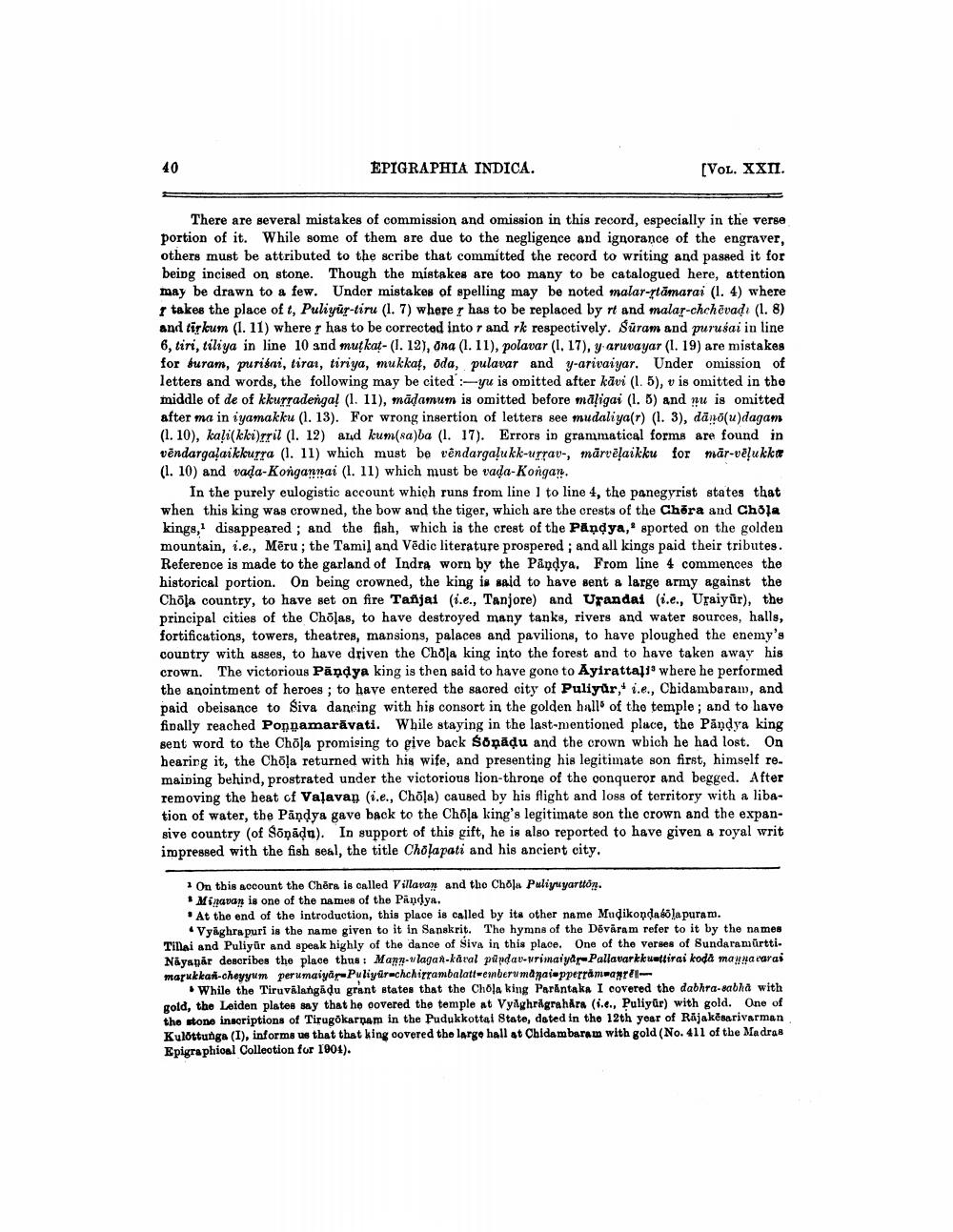________________
EPIGRAPHIA INDICA.
[VOL. XXII.
There are several mistakes of commission and omission in this record, especially in the verse portion of it. While some of them are due to the negligence and ignorance of the engraver, others must be attributed to the scribe that committed the record to writing and passed it for being incised on stone. Though the mistakes are too many to be catalogued here, attention may be drawn to a few. Under mistakes of spelling may be noted malar-stāmatai (1. 4) where
takes the place of t, Puliyur-tiru (1. 7) where : has to be replaced by it and malar-chchevad (1. 8) and tirkum (1. 11) wherer has to be corrected intor and rk respectively. Süram and purusai in line 6, tiri, tiliya in line 10 and mutkat- (1. 12), Ona (1.11), polavar (1. 17), y aruvayar (1. 19) are mistakes for buram, purisai, tirai, tiriya, mukkaļ, Oda, pulavar and y-arivaiyar. Under omission of letters and words, the following may be cited yu is omitted after kāvi (1.5), v is omitted in the middle of de of kkurradenga! (1. 11), mādamum is omitted before māļigai (1. 5) and nu is omitted after ma in iyamakku (1. 13). For wrong insertion of letters see mudaliya(r) (1. 3), danõ(u)dagam (1. 10), kali(kki)rril (1. 12) and kum(sa)ba (1. 17). Errors in grammatical forms are found in vēndargalaikkurra (1. 11) which must be vēndargaļu kk-urrav-, mārvēļaikku for már-vēļukka (1. 10) and vada-Kongannai (1. 11) which must be vada-Kongan,
In the purely eulogistic account which runs from line 1 to line 4, the panegyrist states that when this king was crowned, the bow and the tiger, which are the crests of the Chöra and Chola kinge, disappeared ; and the fish, which is the crest of the Pandya, sported on the golden mountain, i.e., Mēru ; the Tamil and Vēdic literature prospered, and all kings paid their tributes. Reference is made to the garland of Indra worn by the Påndya. From line 4 commences the historical portion. On being crowned, the king is said to have sent a large army against the Chõla country, to have set on fire Tanjai (i.e., Tanjore) and Urandai (i.e., Uraiyūr), the principal cities of the Chēļas, to have destroyed many tanks, rivers and water sources, halls, fortifications, towers, theatres, mansions, palaces and pavilions, to have ploughed the enemy's country with asses, to have driven the Chola king into the forest and to have taken away his crown. The victorious Pandya king is then said to have gone to Ayirattali' where he performed the anointment of heroes; to have entered the sacred city of Puliyur, i.e., Chidambaram, and paid obeisance to Siva dancing with his consort in the golden hall of the temple; and to have finally reached Ponnamarāvati. While staying in the last-mentioned place, the Pandya king sent word to the Chola promising to give back sonāļu and the crown wbich he had lost. On bearing it, the Chola returned with his wife, and presenting his legitimate son first, himself re. maining behind, prostrated under the victorious lion-throne of the conqueror and begged. After removing the beat cf Valavan (i.e., Chola) caused by his flight and loss of territory with a libation of water, the Pandya gave back to the Chola king's legitimate son the crown and the expansive country (of Söņādu). In support of this gift, he is also reported to have given a royal writ impressed with the fish seal, the title Cholapati and his ancient city,
1 On this account the Chöra is called Villavan and the Chola Puliyuyartton.
Minavan is one of the names of the Pandya. . At the end of the introduction, this place is called by its other name Mudikonda bola puram.
• Vyaghrapuri is the name given to it in Sanskrit. The hymns of the Devaram refer to it by the names Tinai and Puliyur and speak highly of the dance of Siva in this place. One of the verses of Sundaramürtti. Näyapar describes the place thus Mann-w lagan-käral pupdav vrimaiya Pallavarkkuuttirai kodd mawa carai marukkari-cheyyum perumaiyarePuliyiruchchirrambalatt=emberumagai-pperramwand
While the Tiruvalangadu grant states that the Chola king Parantaka I covered the dabhra-sabha with gold, the Leiden plates say that he covered the temple at Vynghragrahara (1.e., Puliyur) with gold. One of the stone inscriptions of Tirugókarpam in the Pudukkottal State, dated in the 12th year of Rajakesarivarman Kulottunga (I), informs us that that king covered the large hall at Chidambaram with gold (No. 411 of the Madras Epigraphical Collection for 1904).




